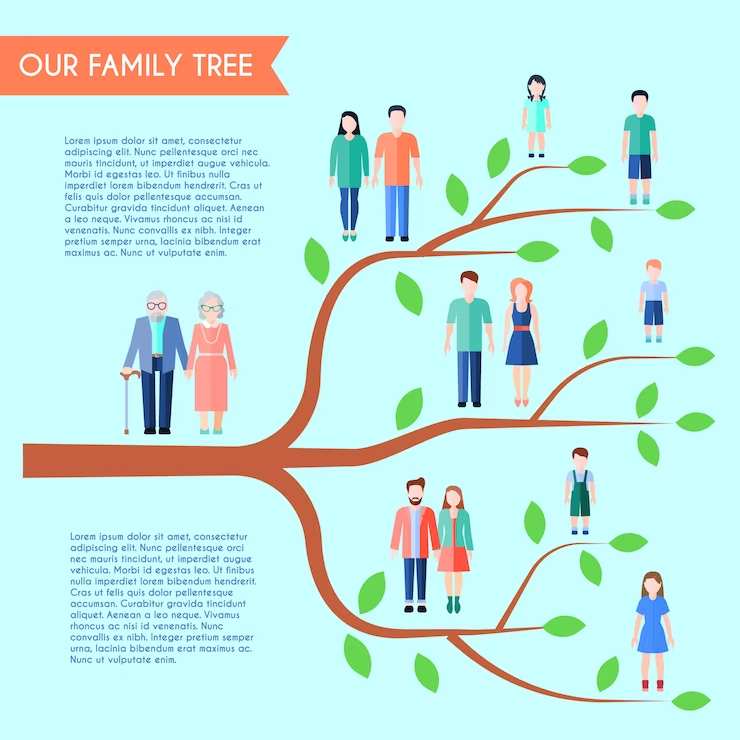In a world brimming with digital devices and fast-paced living, there’s a charming and meaningful way to introduce children to their roots: family tree projects. These projects not only offer hands-on experience but also weave a tapestry of connections that span generations.
As we embark on this creative journey, we’ll delve into the captivating world of family tree projects, discussing their significance, various approaches, and how to craft an engaging and educational experience for children.
How to Do a Family Tree Project?
Embarking on a family tree project is akin to embarking on a journey of discovery.
Here’s a step-by-step guide to get you started:
- Research and Gather Information: Begin by collecting family details. Interview relatives, gather photographs, and jot down names, birthdates, and important milestones;
- Select a Format: Choose a format that resonates with your child’s creativity. It could be a traditional paper-based tree, a digital creation, or even a crafty 3D representation;
- Design and Assemble: Lay out the family tree structure, starting with the youngest generation at the top. Assemble the family members’ names, birthdates, and photographs;
- Add Personal Touches: Encourage your child to add personal touches, such as drawings, anecdotes, and special memories associated with each family member;
- Present and Discuss: Once the project is complete, present it to the family. Use the opportunity to share stories and anecdotes, fostering a sense of connection and understanding.
What is the Best Family Tree Template?
The world of family tree projects offers a plethora of template options to suit various preferences. From traditional templates with branches and leaves to more contemporary designs, the choice is yours. Consider opting for a template that aligns with your child’s interests and artistic inclinations. Digital templates, available through various online platforms, offer customizable options for a modern twist on the traditional family tree.
How Can I Make a Digital Family Tree?
In an age where technology seamlessly integrates with creativity, a digital family tree opens up a world of possibilities.
Here’s how to embark on a digital family tree project:
- Choose a Platform: Explore online platforms or software specifically designed for creating digital family trees.
- Input Information: Input family details, including names, birthdates, and relationships. Many platforms offer the option to add photographs and anecdotes.
- Customize and Enhance: Personalize your digital family tree with colors, fonts, and visual elements that reflect your child’s style.
- Explore Interactive Features: Take advantage of interactive features that allow you to click on family members for additional information and stories.
- Share and Celebrate: Once your digital family tree is complete, share it with family members near and far. It becomes a living legacy that can be continually updated and cherished.
Creating Family Trees with Ease
In a world where technology seamlessly intertwines with creativity, several user-friendly applications empower you to craft captivating digital family trees effortlessly. These apps offer intuitive interfaces, customization options, and the ability to collaborate with family members, making the process both engaging and accessible.
- Ancestry.com: Ancestry.com, a renowned platform for genealogical research, also offers a user-friendly family tree creator. With its vast database and interactive features, it’s an excellent choice for delving into your family’s history;
- MyHeritage: MyHeritage provides a comprehensive family tree builder that allows you to connect with relatives, add photos, and even discover historical records. Its user-friendly interface makes it suitable for both beginners and more experienced genealogists;
- FamilySearch: FamilySearch, operated by The Church of Jesus Christ of Latter-day Saints, offers a free family tree builder. It provides access to an extensive database of records and offers collaborative features for connecting with family members;
- Legacy Family Tree: This software offers robust tools for creating detailed family trees. Its user-friendly interface and options for attaching documents, photos, and sources make it a popular choice;
- Geni: Geni is known for its collaborative family tree-building approach. It enables multiple family members to contribute to the same tree, fostering a sense of shared history.

Enriching the Journey
As you embark on the adventure of creating a family tree project, consider infusing it with additional elements to enhance its depth and significance:
- Oral Histories: Alongside names and dates, include snippets of oral histories and anecdotes from family members. These personal stories breathe life into the branches of your family tree;
- Photographs: Incorporate photographs of family members to provide a visual connection to the past. Images evoke emotions and memories, making your family tree project even more compelling;
- Geographical Context: If possible, include information about the places your ancestors lived. This can help children develop a sense of the broader world and historical context.
A Legacy of Connection
The beauty of a family tree project lies not only in its creative process but in the connections it fosters across generations. As children engage in researching, designing, and presenting their family trees, they are weaving a tapestry of shared experiences, stories, and heritage.
So, whether you choose the traditional path of paper and art supplies or venture into the realm of digital innovation, the journey of creating a family tree project is an enriching and meaningful endeavor. As children delve into the annals of their family history, they not only learn about their roots but also lay the foundation for a stronger sense of identity and belonging.
